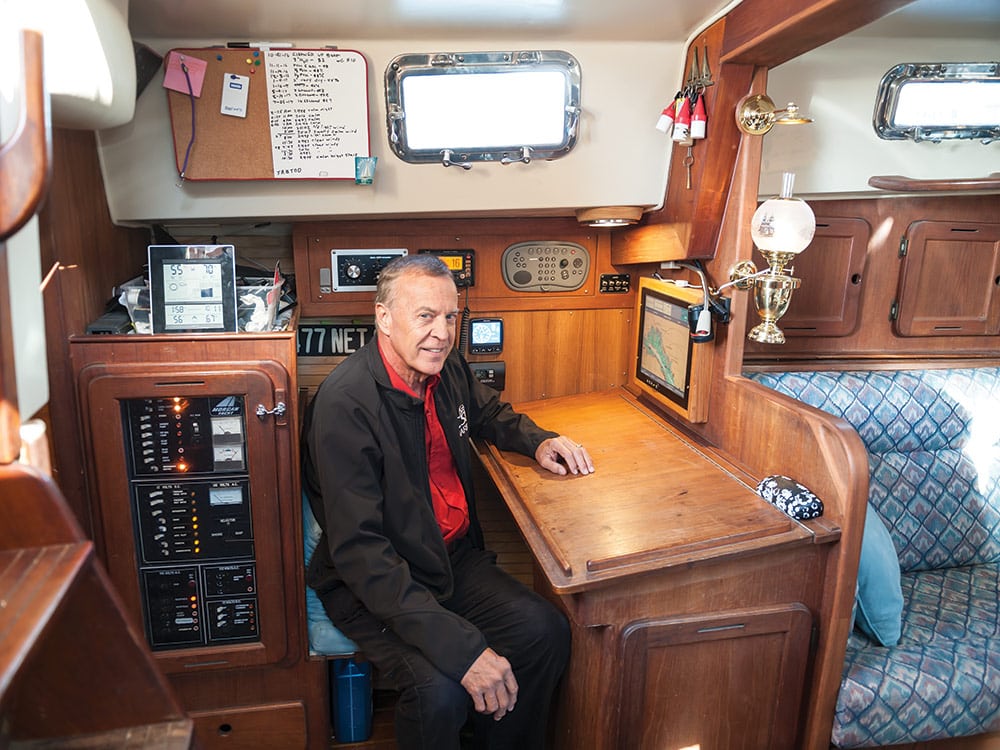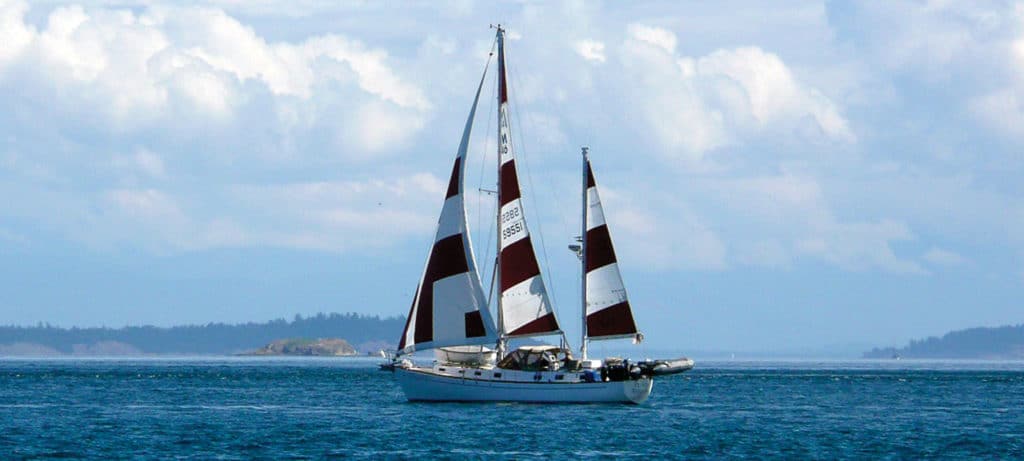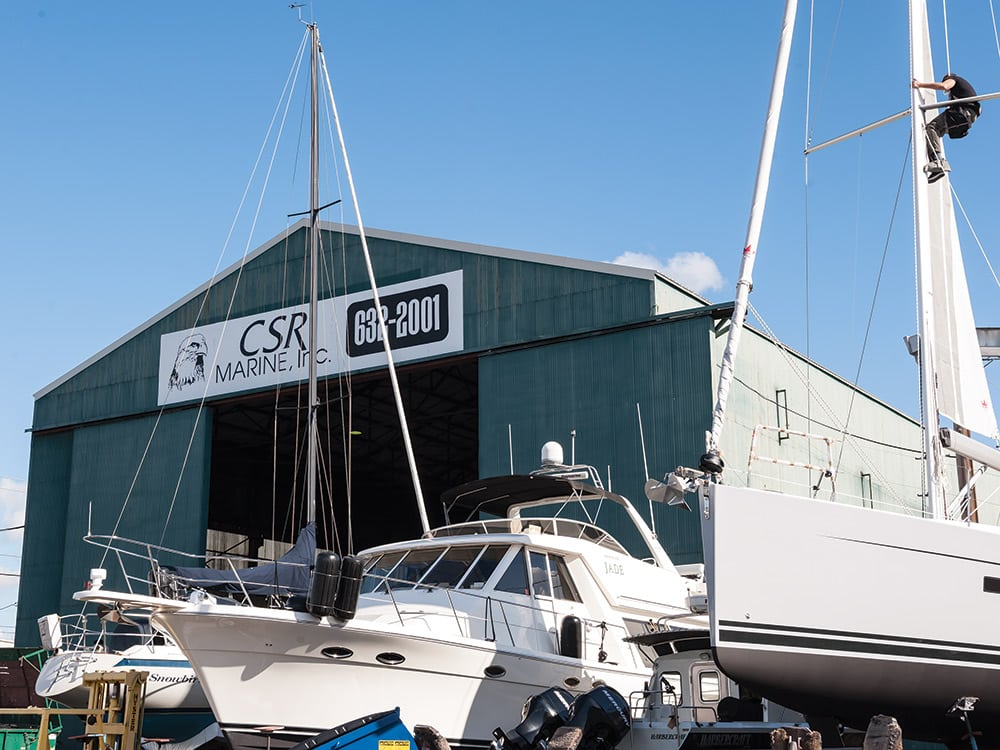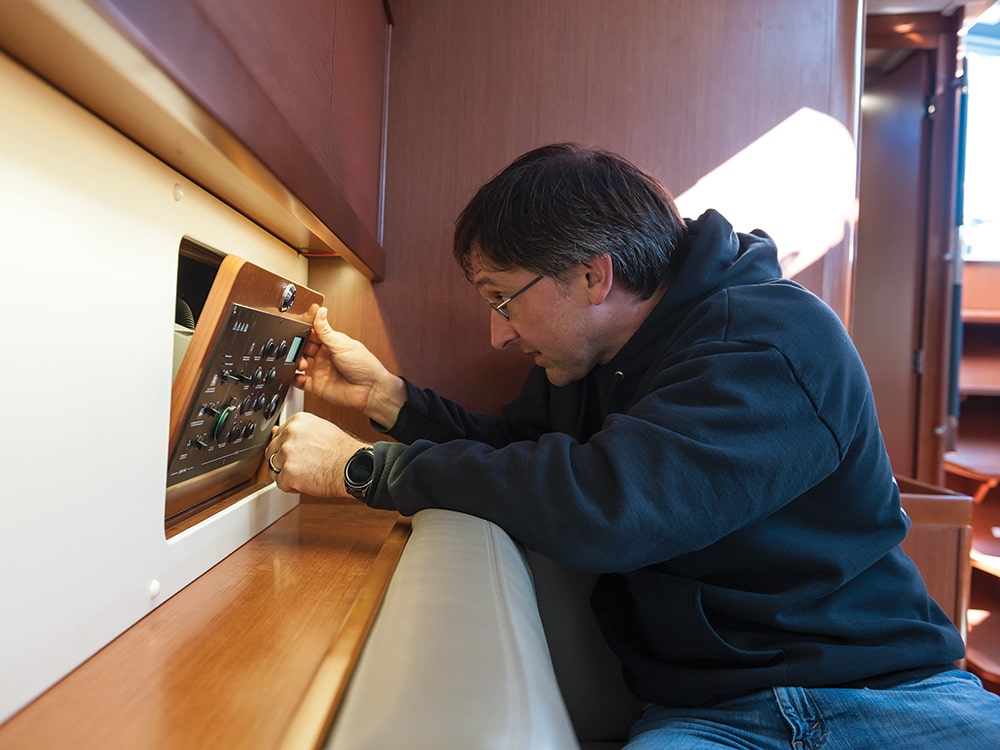
Steve and Malia Gilbert were skiing in British Columbia when a massive storm slapped Puget Sound. Steve immediately tried hailing his Tacoma, Washington, marina but couldn’t connect, so he dispatched his adult sons to check on Princess Kaiulani, the 1979 Morgan 46 that he bought factory-new and raised his family aboard before transitioning to life ashore. The news was grim. The storm had parted dock lines and dislodged moorings, sinking some boats while totaling others. Princess Kaiulani was afloat, but ricocheting vessels had chiseled deep canyons across her topsides. Given the Gilberts’ long-standing connection to their sailboat, Steve and Malia, along with Seattle’s CSR Marine, were determined to restore her, and they used the opportunity to upgrade all major systems, including the boat’s navigation equipment and electronics. Now, many thousands of dollars and several years later, Princess Kaiulani is far more ready for offshore passages than it once was, thanks to new-school technologies, including an automatic identification system device, dual chart plotters, GPS, and digital radar and sonar.
“My work list is much, much smaller than it was,” said Steve, just before he and Malia departed for their annual extended cruise. “After almost 40 years, the boat looks new, and people regularly say that she’s the prettiest boat in the marina.”
Some say that luck is the confluence of opportunity and preparation — apropos words for an electronics refit. True, the “opportunity” can sometimes be a tough pill to swallow, but many refits are undertaken because owners want new technologies — for example, radar and AIS chart overlay — that their old equipment can’t support. While electronics refits can be complex and resource-intensive, upgrades allow you to bolster your situational awareness and increase your on-the-water enjoyment, provided that you negotiate the situation wisely.
Depending on the scale of your project and your do-it-yourself skills, odds are good that you’ll need to hire pros for at least some of an electronics refit, especially if you’re also upgrading data backbones, wiring and battery banks. Because of this, choosing the right service provider is one of the biggest pre-refit decisions you’ll make.
If you’re lucky enough to already have a good relationship with a shop or yard, it’s best to start there, but if you’re new to an area, fresh to cruising or about to hire an expert for the first time, there are some key considerations, starting with dock credibility.
“We recommend that owners interview two or three businesses that they think could do the job,” says Greg Allen, sales manager at Seattle’s S3 Maritime. “Ask around, and ask each business to give you three references. Also, what certifications does each yard have?” Savvy owners will seek out installers who have previously performed similar work and will also ask to meet the project manager to ensure that their experience and professionalism match expectations.
“We’re happy to come and look at a boat,” says Scott Anderson, co-owner of CSR Marine, who explained that this often circumvents unpleasant Pandora’s boxes. “We send out two sets of eyes, and we take a ton of photos.” These images give the shop a detailed look at the vessel, its other existing systems and electronics, and the installation area, all of which impact the bottom line.
Once a service provider has been selected, Allen and Anderson agree that building and sustaining a strong working relationship is a smart move that should start with simple courtesies, such as removing personal belongings before dropping off the boat and never pulling it midway through a refit to go sailing. The latter, they agree, ruins the crew’s cadence and often necessitates multiple hoist rides if the work must be done on land.
“Getting along with a boatyard is like working with a doctor or a lawyer,” says Anderson. “You need to be proactive as an owner.” Here, biweekly (or daily) phone calls to project managers and regular in-person visits are key throughout the refit, and — although not mandatory — occasionally arriving with libations on Friday afternoons is universally appreciated and often leads to outcome-enhancing conversations with the crew.
While online research streamlines product selection and comparison shopping, owners should absolutely involve their project manager in their equipment-purchasing decisions, because their experience and expertise are two of the biggest assets that you’re buying when hiring pros. Likewise, while budget-conscious cruisers might be tempted by online deals, it’s critical to discuss this ahead of time because many shops won’t install or warranty equipment they didn’t sell.
“If you’ve got old wiring, old breakers or an old panel, integrating this old equipment with your new gear could be a big challenge and possibly a safety issue.”
“I feel a responsibility to have an open conversation with an owner about cost and value,” says Allen about advising customers on their equipment selections. “If they’re putting a $40 saddle on a $10 horse, I’ll let them know.” Conversely, Allen and Anderson both advise that a good shop will always speak up if an owner is being penny-wise where minimal additional investment could pay handsome long-term dividends.
“People need to be conscious about scaling a project to their boat,” says Nigel Barron, CSR Marine’s sales and marketing manager. “Every add-on adds complexity and can possibly go wrong and take out the system.” At CSR, owners are advised to carefully consider the feature sets that they need, specifically starting with the chart plotter (more on these in a minute), not just purchase whatever is being advertised.
Each refit job’s timeline and cost ultimately boil down to an individual boat, the owner’s equipment list and a yard’s schedule. It’s important to discuss all the variables before the project starts.

Princess Kaiulani, Steve and Malia Gilbert’s 1979 Morgan 46, is now better equipped than ever to ply her home waters of the Pacific Northwest.
“Are we installing all new wiring?” asks Allen. “Are we pulling the panel?” Allen and Anderson agree that it’s critical that the boat’s supporting infrastructure be up to the task.
“You don’t want to shortchange things on the electrical side,” says Anderson. “If you’ve got old wiring, old breakers or an old panel, integrating this old equipment with your new gear could be a big challenge and possibly a safety issue.” Often, the smart — albeit more expensive — move is to upgrade older electrical systems, including batteries.
“Getting good, clean power is important, and older electronics are susceptible to spikes,” notes Barron. When selecting new house batteries, if weight is irrelevant but dollars count, lead-acid or absorbed glass mat batteries will likely prove most cost-effective. However, “if lithium-ion batteries give you the 2,000 cycles that they are rated at, they could cost the same as lead-acid batteries, and maybe less with labor,” says Allen.
There are differing opinions though, which is why it pays to ask lots of questions. “If you’ll be around civilization, lithium-ion batteries wouldn’t be a bad option,” says Barron. “But if you’re going for a big cruise, why not go with a proven technology that can be easily repaired or replaced?”
Knowing when to physically begin work is the final easily forecast consideration. Here in the States, marine-electronics manufacturers typically release their next-generation equipment between the Fort Lauderdale International Boat Show in early November and the Miami International Boat Show in mid-February. Owners seeking bleeding-edge gear should use these shows to touch, see and smell the equipment; experience its user interface; and possibly leverage boat-show discounts. For owners contemplating extensive upgrades, some electronics shops will even be willing to send someone to the show with you, which can streamline things considerably.
All that said, boatyards are typically busiest from February through June or July, slow during the summer, then hectic again during the fall, up until the holidays. Owners who can be flexible with scheduling often enjoy more dedicated attention if they plan their refit during slack times. If a customer wants their boat by a hard deadline, say June 1, they “need to start planning in October or earlier, and make their decisions by December,” advises Anderson. According to all of the experts interviewed, the most commonly requested electronics upgrades include AIS, radar, sonar, thermal imaging and chart plotters, with the latter typically being the most critical domino. While NMEA 0183 and NMEA 2000 backbones allow networked instrumentation to share data such as wind, temperature, GPS and heading-sensor output, marine-electronics companies design their heavy-lifting electronics to be brand compatible. At the heart of any extensive system is the chart plotter, which is often simply referred to as a multifunction display. Around the plotter is a spiderweb of instrumentation that’s all designed to layer on information. Because of this, users are encouraged to consider each chart plotter’s feature set and its manufacturer’s entire product ecosystem when making a purchase.

Once a chart plotter has been selected, it’s time to consider sensors and antennas. In the case of AIS, costs have plummeted, allowing consumers to buy a listen-only AIS receiver for roughly $500 to $800, while a send-and-receive Class B AIS transceiver starts at around $1,000.
Radars, of course, are a bigger investment, but recent years have brought dramatic advances in what’s available. Solid-state digital circuitry has upstaged magnetron-based analog technology; modern Doppler processing graphically differentiates threatening targets from nonthreatening vessels. In both cases, digital-radar information is easily overlaid atop a chart plotter’s electronic cartography, offering drastically improved situational awareness. Forward-looking sonar has inherent range and speed limitations but is increasingly gaining traction with cruisers who enjoy gunkholing. Finally, all experts cite increased customer interest in thermal-imaging cameras. Unlike other equipment, these devices are typically brand agnostic and display their imagery on most compatible chart plotters.
Once a final purchase order has been agreed upon, Allen and Anderson advise owners to stick to the plan, barring unforeseen circumstances, as this corrals change orders, which cost dollars and daylight. Should the proposed budget start swelling uncomfortably, Barron suggests working with the shop to create a multiyear plan, typically starting with infrastructure such as batteries, breakers, wiring, a data backbone and a chart plotter first, followed by plug-and-play additions as the refit kitty allows.

Irrespective of equipment lists, owners can expect huge returns from their investments on upgraded electrical and electronics systems, starting with far better situational awareness and more enjoyable and rewarding navigational experiences.
While there’s no question that traditional navigation skills are a critical foundation, overlaying up-to-date vector charts with Doppler-enabled radar and AIS data provides a much safer way of visually processing information on long nighttime crossings or in less-than-perfect weather.
Provided that you do some homework, ask the right questions and maintain an open mind, there’s no reason that your next electronics refit project can’t be as successful and rewarding as the dream that Steve and Malia Gilbert realized with Princess Kaiulani, the boat that, for them, will always be part of the family.








